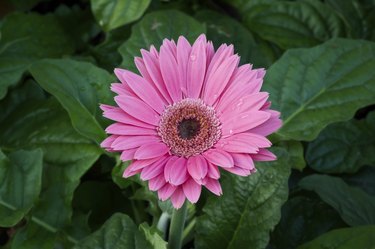
White mold on gerbera daisies (Gerbera jamesonii) signals that powdery mildew has moved in. The fungal disease often troubles these colorful South African natives, which grow in U.S. Department of Agriculture plant hardiness zones 8 through 10. Signs of powdery mildew call for prompt changes in care to eliminate conditions that favor the disease. Depending on how far powdery mildew has progressed, different fungicide treatments help protect healthy plant parts, control mildew's spread and eradicate the disease.
Powdery Mildew Basics
Video of the Day
The fungal species that cause powdery mildew in gerbera daisies affect all parts of the plant. The disease often reveals its presence through small, white splotches on gerbera leaves and shoots. The spots enlarge and grow together, covering other plant parts. Buds and new shoots distort and twist as white, moldlike powder overtakes the plant. Powdery mildew needs a living plant host to survive, but it doesn't need moisture to germinate or spread. Water inhibits powdery mildew growth and, unlike many fungal diseases, powdery mildew spores can die in water. Shaded areas and temperatures between 60 and 80 degrees Fahrenheit promote powdery mildew and its spread.
Video of the Day
Cultural Corrections
Mildew intervention starts with conditions that help fight the disease. If your gerberas grow in shade, it's time for relocation. Powdery mildew struggles in high temperatures and sun, but shade encourages its spread. The fungus dies when leaf temperatures exceed 95 F. Give gerberas full, direct sun and well-draining soil. In the hottest climates, provide protection from intense, midday rays. Provide good air circulation, and avoid crowding the plants. Water gerberas regularly and deeply, and then allow the soil to dry slightly before watering again. Overhead watering can promote other fungal diseases, but it washes off powdery mildew fungi and damages spores. Water gerberas midmorning so the plants dry before the evening.
Protectant Sprays
In the earliest stages of a powdery mildew attack, protectant fungicides help prevent the disease's spread. Best when used as preventives or at the earliest symptoms, sulfur-based sprays protect healthy plant tissue from powdery mildew's assault. Always test a small portion of the plant before you proceed with spraying, and never apply sulfur in temperatures exceeding 90 F. Mix 2 to 2 1/4 tablespoons of wettable sulfur with 1 gallon of water in a garden sprayer. Mix well, and spray all the plant surfaces, including the leaf undersides. Repeat every five to 10 days, as needed. Wear protective clothing, including gloves and safety eyewear, and avoid contact with exposed skin. Wash thoroughly with soap and water after handling the sulfur.
Advanced Infections
Once powdery mildew progresses on your gerbera daisies, protectant sprays won't help much. Horticultural oil helps eradicate advanced powdery mildew while protecting healthy plant parts. Apply oils when temperatures fall between 40 and 90 F, and test spray a small area first. Never spray gerberas stressed from lack of water, and never use oil sprays within two weeks of using sulfur. Mix 2 1/2 to 5 tablespoons of horticultural oil concentrate with 1 gallon of water in a sprayer, and thoroughly wet all plant surfaces. Use the highest rate for severe, fast-moving infections. Repeat weekly until powdery mildew is in check, then repeat every two to three weeks, as needed. Use the same safety precautions used for sulfur spray.
- The National Gardening Association: White Mold on Gerbera Daisy
- University of Florida IFAS Extension: Powdery Mildew of Gerbera Daisy
- UC Statewide IPM Online: Gerbera Daisy, Barberton Daisy, Transvaal Daisy -- Gerbera Jamesonii Family Asteraceae (Sunflower Family)
- UC Statewide IPM Online: Powdery Mildew on Ornamentals
- Missouri Botanical Garden: Gerbera Jamesonii